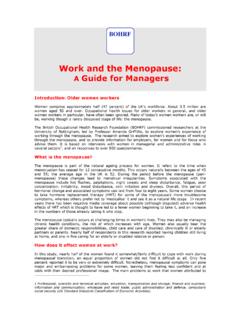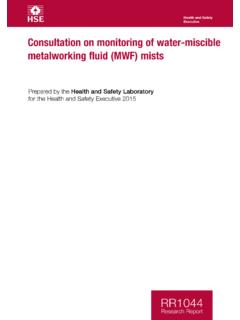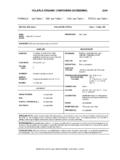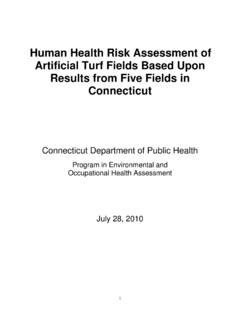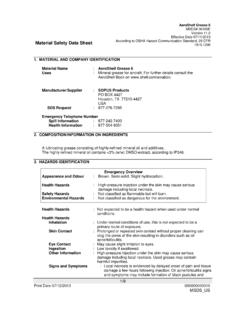Transcription of Review of Health Risks for workers in the Waste and ...
1 Review of Health Risks for workers in the Waste and recycling industry Report prepared by: Alison Searl BSc(Hons) PhD MEnvS. Joanne Crawford BSc(Hons) PhD MSc (chapter 10). Date of report: 18th May 2012. IOM contract no: 611-00491. Contents Glossary Executive summary 1 Introduction OVERVIEW. AIMS. REPORT STRUCTURE. 2 Methods LITERATURE Review . industry QUESTIONNAIRE. EXPOSURE ASSESSMENT. RISK ASSESSMENT. 3 Occupational ill Health in the UK Waste industry INTRODUCTION. SICKNESS ABSENCE DATA AND ROUTINE Health SURVEILLANCE. HSE ENFORCEMENT ACTIVITY. PEER REVIEWED LITERATURE. industry PERCEPTION OF THE MAJOR Health ISSUES. DISCUSSION AND CONCLUSIONS. 4 Exposure to airborne dust INTRODUCTION. Health EFFECTS. HAZARD ASSESSMENT. EXPOSURE. RISK ASSESSMENT. DISCUSSION AND CONCLUSIONS. 5 Bioaerosol INTRODUCTION. BIOAEROSOL COMPONENTS. Health EFFECTS. EXPOSURE RESPONSE INFORMATION. EXPOSURE. Health RISK ASSESSMENT. CONCLUSIONS. 6 Metals INTRODUCTION.
2 Health EFFECTS. EXPOSURE. RISK ASSESSMENT. CONCLUSIONS. 7 Landfill gas and other volatile substances i INTRODUCTION. LANDFILL GAS, ANAEROBIC DIGESTION. VOCs AND RELATED SUBSTANCES ASSOCIATED WITH COMPOSTING AND. OTHER PROCESSES INVOLVING ORGANIC WASTES. CHLOROFLUOROCARBONS, HYDROCHLOROFLUOROCABONS. RECOVERY OF FUEL AND LUBRICANTS FROM END OF LIFE VEHICLES. SOLVENT COLLECTION AND RECOVERY. COLLECTION AND INCINERATION OF CHEMICAL Waste . SOLVENTS AND OTHER CHEMICALS USED IN MATERIALS recycling . PROCESSES. CONCLUSIONS. 8 Semi-volatile organic chemicals INTRODUCTION. DIOXIN. POLYAROMATIC HYDROCARBONS (PAHs). POLYCHORINATED BIPHENYLS (PCBs). BROMINATED FIRE RETARDANTS. CONCLUSIONS. 9 Infections INTRODUCTION. Health EFFECTS. EXPOSURE. RISK ASSESSMENT. CONCLUSIONS. 10 Risks from Heat Illness in the Waste recycling industry INTRODUCTION. THERMOREGULATION AND HEAT BALANCE. THE PHYSICAL AND MENTAL IMPACT OF INCREASING TEMPERATURES. WHAT IS HEAT STRESS /HEAT ILLNESS?
3 RISK FACTORS FOR HEAT ILLNESS. EXPOSURE Risks . CONCLUSIONS. 11 Overall risk assessment and recommendations INTRODUCTION. RISK ASSESSMENT BY PROCESS. DISCUSSION. CONCLUSIONS. RECOMMENDATIONS. 12 References Appendix 1: Questionnaire responses ii Glossary ACGIH American Conference of Governmental Industrial Hygienists ACH air changes per hour AM arithmetic mean ATSDR (US) Agency for Toxic Substances and Disease Registry Bioaerosol Airborne particles composed of living organisms or fragments of previously live organisms such as fungi and bacteria CI confidence interval cfu colony forming units (used to describe quantity of viable bacteria or fungi -3 3. cfum calculated concentration of viable bacteria or fungi as cfu per m of air CNS central nervous system Defra Department of Enviornment, Food and Rural Affairs Endotoxin constituent of the outer cell wall of Gram-negative bacteria that is associated with the adverse effects of many common infections EU endotoxin unit (about ng).)
4 FEV1 forced expiratory volume in 1 second (measure of lung function). FVC forced vital capacity (measure of lung function). GC-MS gas chromatograph-mass spectrometer GM geometric mean GSD geometric standard deviation Inhalable Particles approximately less than 100 m diameter that are capable of entering the respiratory system IPCS International Programme for Chemical Safety LEV local exhaust ventilation MVOC microbial volatile organic compound NOAEL no observed adverse effects level ODTS organic dust toxic syndrome OEL Occupational exposure limit PCDD/Fs Polychlorinated dibenzo dioxins and furans PPE personal protective equipment PM10 approximately particles of less than 10 m diameter that are capable of penetrating the respiratory system to the lung (the thoracic fraction). iii Respirable Particles approximately less than 4 m diameter that are capable of penetrating to the gas exchange region of lung RPE Respiratory Protective Equipment Odds ratio the ratio of the odds of an event occurring in one group (exposed) to the odds of it occurring in another group (control), or to a sample-based estimate of that ratio OSHA (US) Occupational Safety and Health Administation NIOSH (US) National Institute for Occupational Health and Safety SD standard deviation TCDD 2,3,7,8- Tetrachlorodibenzo-para-dioxin TEQ toxic equivalents method of expressing the toxicity of a mixture of related compounds in terms of the dose of a single marker compound that would be of equivalent toxicity TLV Threshold Limit Value (occupational exposure limit set by ACGIH or other bodies).
5 TWA time weighted average VOC volatile organic compound WEEE Waste electrical and electronic equipment WEL Workplace Exposure Limit set by HSE. WHO World Health Organization iv Executive summary INTRODUCTION. This study was commissioned by the British Occupational Health Research Foundation on the behalf of the Environmental Services Association Education Trust (ESAET). In recent years the Waste and recycling industry has moved away from its reliance on disposal in landfill to much higher levels of recycling and recovery. In addition, new materials and technologies are entering the Waste chain. These changes are likely to have led to significant changes in the nature and magnitude of the associated Risks to worker Health . The aims of the Review were to: Provide a resource that will assist operators in the identification of potential hazards, assessment of the Health Risks to their workers and implementation of appropriate exposure prevention or control measures.
6 Identify which of the occupational Health issues selected by ESAET for Review are associated with the industry 's main activities and provide the basis for compiling risk assessments and identifying appropriate control measures; and Identify any occupational Health issues that present unacceptable levels of risk (if any), require unique or burdensome control measures or where additional research is required in order to come to a clearer conclusion. The study involved a comprehensive Review of relevant published literature and a limited survey of industry representatives about current practice in relation to Health surveillance, exposure monitoring and their perceptions of the major Health issues. In addition, exposure modelling was undertaken to inform the risk assessments that were undertaken for each of the hazards and processes considered. POTENTIAL HAZARDS. After discussion with EASET representatives, this study focused on airborne dust, bioaerosol, chemicals used or liberated in specific operations, heavy metals and/or carcinogens liberated in recycling , infectious agents, high temperatures and heat related illness.
7 The technologies considered were anaerobic digestion, composting, high temperature thermal treatments, auto- clave, Materials Recovery Facilities (MRFs), Mechanical Biological Treatment (MBT), Household Waste recycling Centres (HWRCs) and Transfer Stations, glass, plastic and wood separation, Waste Electrical and Electronic Equipment (WEEE), fridge recycling , metal crushing and aluminium separation and paper and cardboard baling. Some consideration has also been given to landfill, as this is still an important disposal route for residual Waste in large parts of the UK. ASSESSMENT OF Risks . Dust The current UK regulatory limits for inert dusts are not intended to be protective for most dusts that are encountered in the Waste industry which have elevated organic matter and/or metals contents and would be expected to be more hazardous to Health . The HSE's own Working Group on Actions to Control Chemicals (WATCH) have advised that the current regulatory limits are not sufficient to protect against the risk of serious respiratory illness, even for exposures to inert dust.
8 The IOM recommends that employers should aim to keep -3 -3. exposure to respirable inert dust below 1 mgm and inhalable inert dust below 5 mgm . Most dusts encountered in the Waste industry have elevated organic matter or metals -3. contents and may give rise to adverse effects at exposure concentrations well below 1 mgm . The Review findings suggest that exposures to dust at many Waste handling sites are likely to be associated with significantly increased Risks of chronic respiratory illness. Harmful levels of exposure to airborne dust may be a particular issue during cleaning and maintenance operations at most types of Waste handling facilities. Frequent equipment failure, entry into relatively confined spaces and the use of compressed air to clear blockages may all v contribute to elevated exposures to airborne dust at some sites. The use of compressed air should be discontinued in favour of other methods. Bioaerosol Exposures to bioaerosol at a substantial proportion of composting sites and associated with Waste reception/stored wastes at many other Waste facilities are likely to be associated with increased Risks of respiratory illness and possibly gastrointestinal symptoms and fatigue.
9 The Risks are likely to be minimal where processes are entirely automated and enclosed with effective extraction ventilation and a good supply of fresh air to the workplace. Elevated exposures are most likely where workers are working on picking lines or in close proximity to processes such as crushing, shredding, grading, sieving, conveyor transfer or filling that are not entirely contained with extract ventilation. workers with pre-existing respiratory conditions such as asthma or who are previously sensitised to moulds are at particular risk and may experience an exacerbation of symptoms at very low exposure levels. It is probable that workers with increased susceptibility leave the industry because their symptoms become intolerable. Allergic illness is likely to be a significant issue for workers who remain in post for periods of months to years. About 5% of the population are sensitised to common moulds and a greater proportion of the population are atopic (have an increased likelihood of developing allergies) and are at increased risk of becoming sensitised.
10 Any workers with compromised immune function (for example, due to medication) are also at risk of aspergillosis. Metals Exposures to harmful levels of heavy metals occurs at some metals recovery facilities such as scrap yards with a substantial proportion of scrap yard workers having blood lead levels that exceed the thresholds for the development of toxic effects. Some WEEE processing operations are also associated with exposures to harmful levels of heavy metals, particularly lead and mercury. Inadvertent ingestion is likely to be an important route of exposure in both metals recovery operations and WEEE processing. Inadvertent ingestion may arise as a result of subconscious hand to mouth contact and through contamination of cigarettes, food and drinking vessels as a result of dirty hands and can be a significant route of exposure to hazardous substances at work. It is possible that mixed metal exposures could give rise to toxicity as a result of additive effects even where the WELs of individual metals are met.
